Introduction
This document offers African honey bee (AHB) related recommendations and precautions specific to outdoor workers in Florida. Outdoor workers should be aware of the presence of AHBs in Florida. This awareness should include a healthy respect and caution toward all stinging insects and a realization of the importance of honey bees nationwide. Furthermore, it may be helpful for outdoor workers to know some basic biological and behavioral characteristics of AHBs; this prior knowledge is presupposed for the recommendations in this document. Please see the "Additional Resources" section at the end of this document for more information.
What's in a name?
In popular literature, "African," "Africanized," and "killer" bees are terms that have been used to describe the same honey bee. However, "African bee" or "African honey bee" most correctly refers to Apis mellifera scutellata when it is found outside of its native range. A. m. scutellata is a subspecies or race of honey bee native to sub-Saharan Africa, where it is referred to as "Savannah honey bee" given that there are many subspecies of African honey bee, making the term "African honey bee" too ambiguous there. The term "Africanized honey bee" refers to hybrids between A. m. scutella and one or more of the European subspecies of honey bees kept in the Americas. There is remarkably little introgression of European genes into the introduced A. m. scutellata population throughout South America, Central America, and Mexico. Thus, it is more precise to refer to the population of African honey bees present in the Americas as "African-derived honey bees." However, for the sake of simplicity/consistency, we will refer to African-derived honey bees outside of their native range as "African honey bees" or "AHBs".
African Bee Defensive Behavior
Although they typically do not attack unless provoked, AHBs can be extremely sensitive to disturbances and respond negatively when encountered. Nearly all encounters between AHBs and people occur when the bees perceive an immediate threat to the colony and when people are not aware that there is a colony in the vicinity until it has been disturbed. Common causes of disturbances include lawn mowers or other heavy machinery. Usually, foot traffic by people or animals is not enough to upset a colony.
The following outdoor activities may agitate a bee colony:
- operating heavy machinery (tractor, chainsaw, etc.),
- mowing grass,
- cutting down, pruning, or manipulating trees/shrubbery, and
- causing any loud noise or heavy vibration.
Where AHB Colonies Can Be Found
AHBs utilize a variety of nesting sites in outdoor settings. AHBs will nest above- or below-ground, in natural or artificial crevices, and in urban or rural areas. In forested or slightly wooded areas, AHB nests generally will be found in three typical locations: ground cavities near the base of trees (Figure 1), suspended from a tree branch (Figure 2), or inside a hollow void on a branch/in the trunk (Figure 3). Bees found gathering pollen and nectar on flowers do not necessarily indicate that a colony is nearby. Foraging bees can travel long distances and do not represent any real danger.
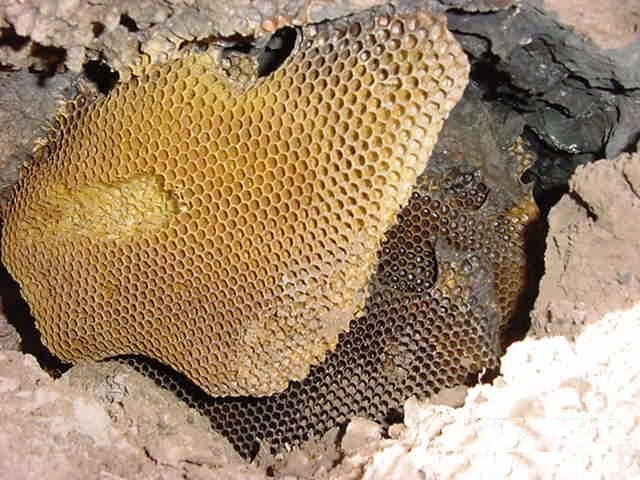
Credit: J. D. Ellis, UF/IFAS Extension
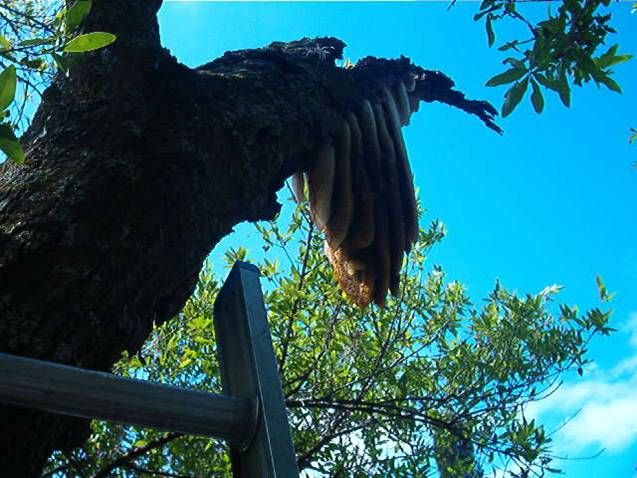
Credit: Insect IQ

Credit: M. K. O'Malley, UF/IFAS Extension
Perhaps the most important and most useful recommendation for any outdoor worker is to be aware of their surroundings at all times and to inspect any area before entering, especially if the area is not frequented by human traffic.
- Watch for bees flying fast and straight into and out of an object or area. This behavior is an indication that a colony may be nearby.
- AHBs will nest in the ground, including in burrows, meter boxes, irrigation valve boxes, electrical boxes, etc.
- Approach potential nesting sites with caution.
- AHBs will use any protected location or void to establish a colony. Any place where you have seen a paper wasp nest could house an AHB colony.
Common nesting locations for AHBs:
- Eaves under roofs
- Water meter boxes
- Maintenance holes
- Electrical boxes
- Gutter downspouts
- Abandoned vehicles
- Abandoned appliances
- Empty containers
- Empty flower pots
- Lumber piles
- Utility infrastructures—power poles, light poles, etc.
- Old tires
- Garages
- Outbuildings
- Sheds
- Walls
- Chimneys
- Attics
- Soffits
- Under portable buildings, mobile homes, sheds, and dog houses
- Bird nest boxes
- Hollowed or dead trees
- Playground equipment
- Exposed tree branches
Figures 4–7 illustrate what AHB colonies might look like in some areas described above.
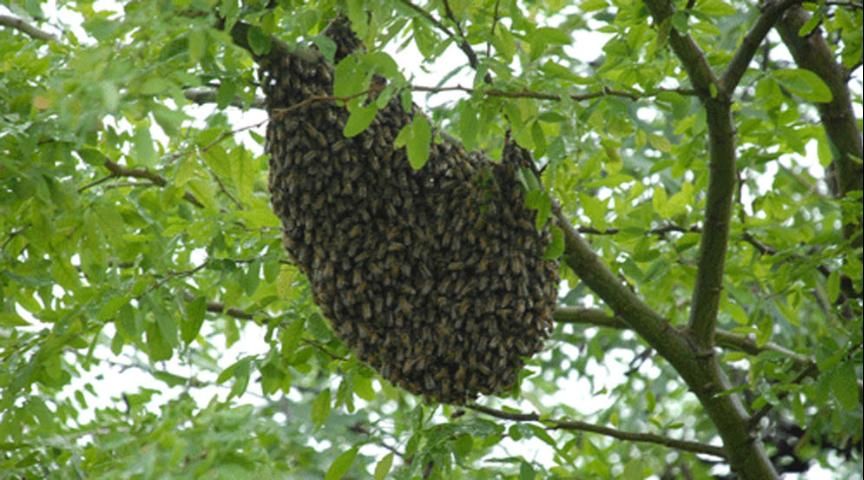
Credit: M. K. O'Malley, UF/IFAS Extension
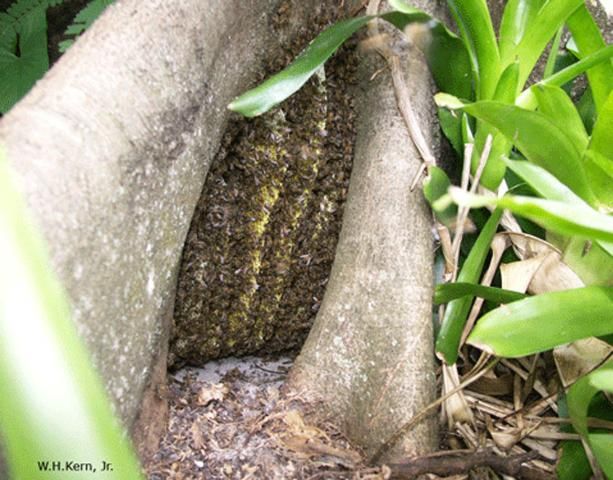
Credit: W. H. Kern, Jr., UF/IFAS Extension
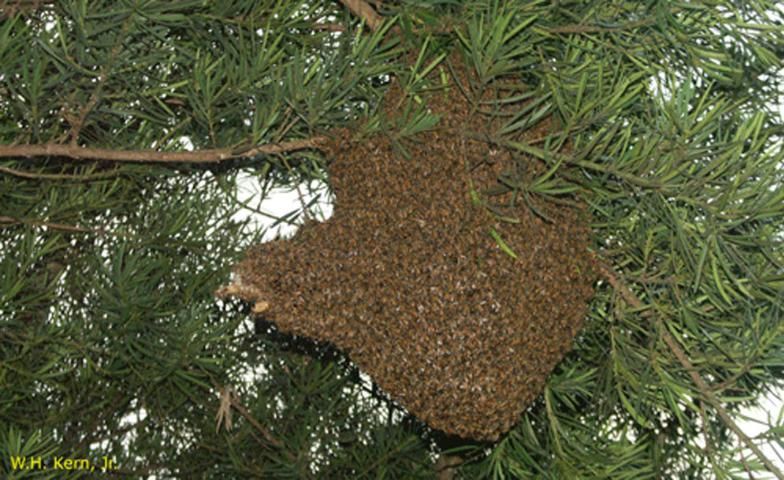
Credit: W. H. Kern, Jr., UF/IFAS Extension
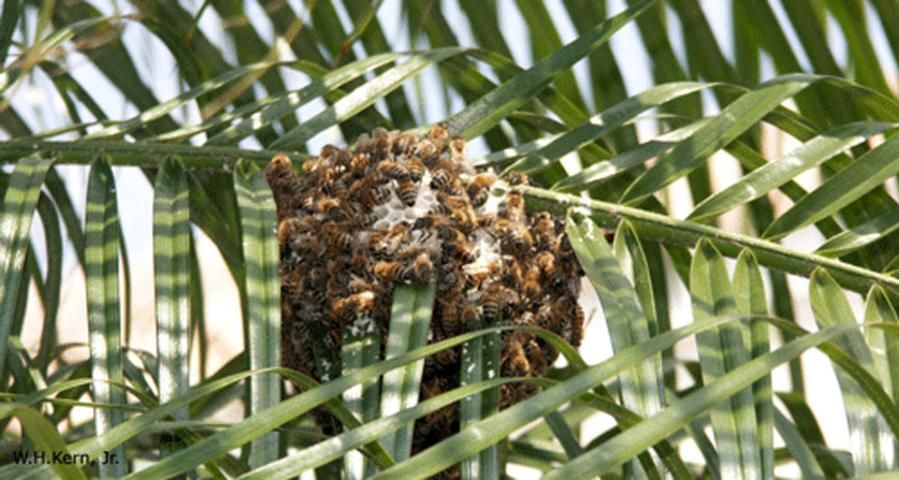
Credit: W. H. Kern, Jr., UF/IFAS Extension

Credit: Insect IQ
What to Expect
African honey bees are more defensive than are European bees, the latter of which are the honey bees beekeepers manage. African honey bees defend their nests readily and often with little provocation. Hundreds to thousands of bees can fly out of a provoked colony, following the provoking human/animal for some distance. Following provocation, the colony may remain agitated the rest of the day.
What to Do if a Colony is Found/Disturbed
Stay away from any honey bee colony you find nesting. The state of Florida recommends that nuisance honey bees (https://edis.ifas.ufl.edu/in1005 and https://edis.ifas.ufl.edu/in790) found nesting outside of hives managed by a beekeeper (like those nesting in tree cavities, walls, water meter boxes, etc.) be either (1) removed from the nest site by a registered beekeeper (https://www.fdacs.gov/Agriculture-Industry/Bees-Apiary/Beekeeper-Registration) or trained Pest Control Operator (PCO) or (2) eradicated by a PCO. Consult the publication "Choosing the Right Pest Control Operator for Honey Bee Removal: A Consumer Guide" (https://edis.ifas.ufl.edu/in771) for advice on hiring a PCO. It is the responsibility of the property owner to deal with an unwanted swarm (https://edis.ifas.ufl.edu/in970) or colony of honey bees. To find a registered beekeeper or PCO who offers removal or eradication services, visit: https://www.fdacs.gov/Consumer-Resources/Consumer-Rights-and-Responsibilities/Pest-Control/Honey-Bee-Removal-or-Eradication-in-Florida. For more information on African honey bees, see https://www.fdacs.gov/Consumer-Resources/Health-and-Safety/Africanized-Honey-Bees or https://edis.ifas.ufl.edu/topic_africanized_honey_bee.
It is important not to panic if a honey bee colony is disturbed. The first thing one should do when the subject of a bee colony's defensive response is RUN to a protected area. Bees elicit defensive responses to protect the resources (honey, brood, pollen, etc.) of the colony. Sting victims should leave the attacking colony's area as quickly as possible. While running, the sting victim should cover their nose and mouth to prevent bees from entering airways. Defensive bees are attracted to dark areas (eyes, ears, up the nose, etc.) and carbon dioxide emissions.
African bees have been known to pursue a possible intruder for some distance. A sting victim should attempt to enter a building, vehicle, or other enclosed structure. A few bees may enter the enclosure with the victim; however, the victim should not exit the enclosure, even if bees are inside. It is preferable to sustain a small amount of stings from the few bees that followed the victim inside rather than to be outside with the several hundred or more agitated bees. Sting victims should not jump into water or attempt to hide in bushes.
It may be wise for outdoor workers to carry some form of personal protective equipment (PPE) such as a veil or sting suit when working outdoors. Several products are available that can offer immediate emergency protection from stinging insects and foldup into a small, portable size. Bee veils that cover the head and neck area are available from most beekeeping supply companies.
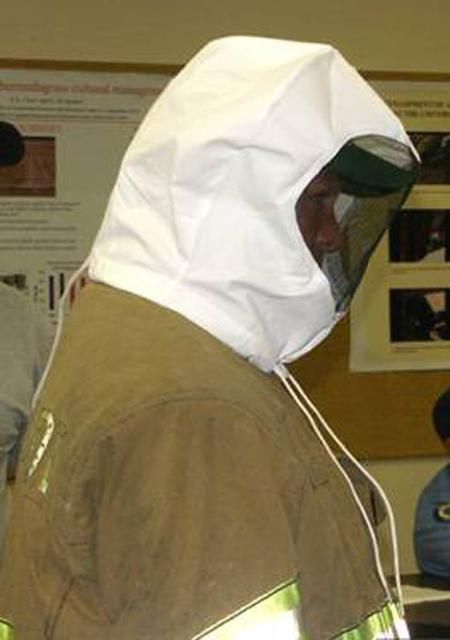
Credit: W. H. Kern, Jr., UF/IFAS Extension
If Stinging Occurs
Generally, honey bee stings result in localized swelling and some skin inflammation. When a honey bee stings, it leaves behind a stinger attached to a venom sac. The sac actively pumps venom into the victim. When stung, the stinger and venom sac should be gently removed from the skin. If a victim receives multiple or hundreds of stings, it is important that they receive assistance removing the stingers (with venom sacs) to prevent excess venom from being released into the body. The stung areas should be washed with soap and water. A cold or ice pack, wrapped in cloth, may be held on the sting area for a few minutes or sting swabs can be used following their labeled directions. Acetaminophen may be taken for pain and antihistamines can be taken for swelling and discomfort at the sting site(s).
For those who are allergic to honey bee venom, a single sting may trigger a severe, possibly fatal, allergic reaction. Victims of bee stings should watch for signs of a severe allergic reaction. These include:
- large areas of swelling (e.g., an entire leg),
- abnormal breathing or wheezing,
- tightness in the throat or chest,
- dizziness,
- hives,
- fainting,
- nausea or vomiting, and
- persistent pain or swelling (i.e., persists for more than two weeks).
If any of these symptoms occur, the victim must seek emergency medical attention or call 911 immediately.
Preventative Measures
Homeowners, park service employees, landscapers, tree service specialists, and others who may work outdoors should take the following precautions to reduce the chances of people-bee encounters.
- Fill any holes under or around the base of trees. This can be accomplished simply by collapsing the hole or filling it with dirt from the surrounding area. This precaution limits AHB access to the area around the base of a tree and makes them less likely to nest there.
- Fill or cover holes larger than 1/8 of an inch located in potential nesting sites. This can be done by stapling or nailing screen mesh around the hole or filling the hole with expandable foam or other filler materials. This includes holes in tree trunks or at the base of trees.
- Patrol wooded areas regularly—especially during swarm season in the spring and fall. Look for bees flying into and out of any hole; such activity may be a sign that a bee colony is in the area (bees on flowers are not a threat or a sign of a nearby colony).
- Contact a PCO or registered beekeeper if you have reason to believe that bees are nesting in or around a tree. See the Resources section for links and more information.
Additional Resources
Choosing the Right Pest Control Operator for Honey Bee Removal: A Consumer Guide, EDIS https://edis.ifas.ufl.edu/in771. UF/IFAS Extension publication that offers recommendations to any Floridian in need of contracting bee removal specialist.
Bee Proofing for Florida Citizens, EDIS https://edis.ifas.ufl.edu/in741. UF/IFAS Extension publication that instructs homeowners and property owners in the specifics of bee proofing and its importance.
Frequently Asked Questions about the African Honey Bee in Florida, EDIS https://agrilife.org/masterbeekeeper/files/2015/04/FAQ-about-AHB-in-FL.pdf
UF/IFAS Extension EDIS document that addresses questions frequently asked about the African bee in Florida.
What to do About African Honey Bees: A Consumer Guide, EDIS, https://agrilife.org/masterbeekeeper/files/2015/04/What-to-do-about-AHB.pdf. UF/IFAS Extension EDIS document that offers recommendations and precautions to Florida's general public about the African honey bee.
Florida Department of Agriculture and Consumer Services', Division of Plant Industry, Bureau of Plant and Apiary Inspection, African Honey Bee Page https://www.fdacs.gov/Consumer-Resources/Health-and-Safety/Africanized-Honey-Bees